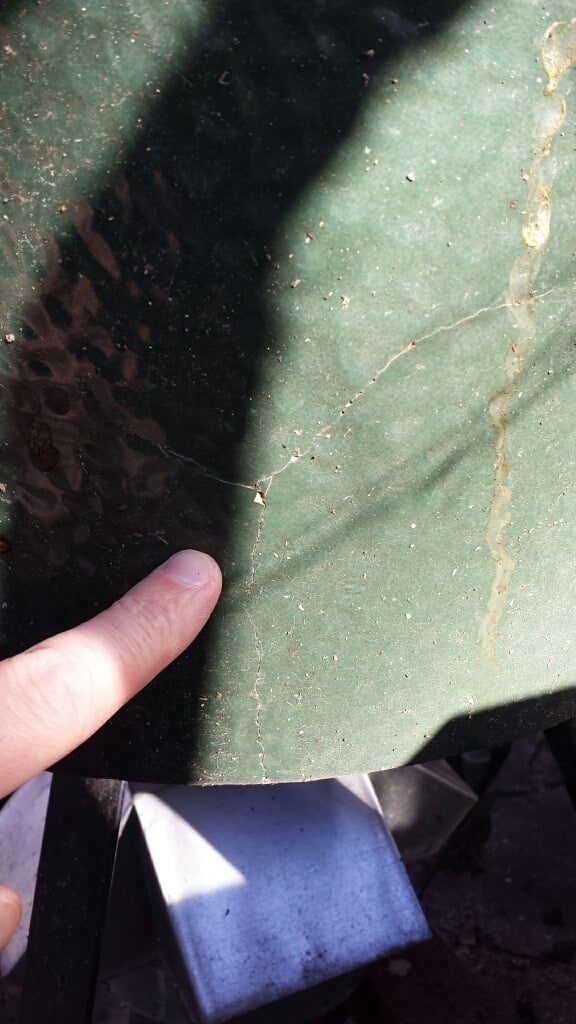Welcome to the EGGhead Forum - a great place to visit and packed with tips and EGGspert advice! You can also join the conversation and get more information and amazing kamado recipes by following Big Green Egg to Experience our World of Flavor™ at:
Want to see how the EGG is made? Click to Watch
Facebook | Twitter | Instagram | Pinterest | Youtube | Vimeo
Share your photos by tagging us and using the hashtag #BigGreenEgg.
Share your photos by tagging us and using the hashtag #BigGreenEgg.
Want to see how the EGG is made? Click to Watch
Firebox Repair
Options

MO_Eggin
Posts: 282
I purchased my LBGE in January 2008. A few years later, I developed the typical crack in the firebox (no slit), and over time the crack spread both in length and width. In January of this year, I discovered a hairline crack in the base, running from back side through the bottom up to the draft door.

This crack more or less lines up with the crack in my firebox, which now has a roughly 1/2 inch gap.

I picked up warranty replacements of the base, firebox and fire ring without any hassle, and did not need to turn in the old parts. So, I've continued to use the old parts, for everything up to pizza temps (~600), in large part because my egg is on a concrete paver patio and not adjacent to anything flammable; it's also in a nest, which presses the halves together. However, I have noticed that the back side of the egg - where the firebox crack is located - is hotter to the touch than the immediately surrounding areas, which motivated me to try a fix.
I picked up a tub of MEECO's Red Devil 610 Refractory Cement, which is premixed and rated to 3000*, from Amazon. I removed the egg's innards, put some cement into a sandwich bag with a corner cut off, and piped it into the crack; also used my finger to try and get good coverage.

outside (note the scorching around the crack):
I carefully reassembled the egg, then allowed the cement to dry for 2 days, with the bottom vent cracked for airflow. Next, I made a very small fire on the opposite end of the firebox, ran about 225-250 for 3 hours.

The next day, I cooked indirect at 250 for about 3 hours, then increased to 450 direct for about an hour. The color of the cement is now darker gray, but is holding up well without bubbling or cracking and appears to have met my goal of eliminating the direct radiant heat exposure to the base.

TL;DR - cracked firebox repaired with refractory cement, holding up after a couple of cooks.

This crack more or less lines up with the crack in my firebox, which now has a roughly 1/2 inch gap.

I picked up warranty replacements of the base, firebox and fire ring without any hassle, and did not need to turn in the old parts. So, I've continued to use the old parts, for everything up to pizza temps (~600), in large part because my egg is on a concrete paver patio and not adjacent to anything flammable; it's also in a nest, which presses the halves together. However, I have noticed that the back side of the egg - where the firebox crack is located - is hotter to the touch than the immediately surrounding areas, which motivated me to try a fix.
I picked up a tub of MEECO's Red Devil 610 Refractory Cement, which is premixed and rated to 3000*, from Amazon. I removed the egg's innards, put some cement into a sandwich bag with a corner cut off, and piped it into the crack; also used my finger to try and get good coverage.

outside (note the scorching around the crack):

I carefully reassembled the egg, then allowed the cement to dry for 2 days, with the bottom vent cracked for airflow. Next, I made a very small fire on the opposite end of the firebox, ran about 225-250 for 3 hours.

The next day, I cooked indirect at 250 for about 3 hours, then increased to 450 direct for about an hour. The color of the cement is now darker gray, but is holding up well without bubbling or cracking and appears to have met my goal of eliminating the direct radiant heat exposure to the base.

TL;DR - cracked firebox repaired with refractory cement, holding up after a couple of cooks.
LBGE - St. Louis, MO; MM & LBGE - around 8100' somewhere in the CO Front Range
Comments
-
Looks like it came out well. I have no idea if any of the chemicals in the stuff that you used, or any of the other stuff that is used to repair plate setters and fireboxes, etc. are harmful, but my opinion is why take a chance. Especially in the case of the base and firebox which is under warranty. Sorry for being a Debbie Downer.
Categories
- All Categories
- 182.7K EggHead Forum
- 15.7K Forum List
- 459 EGGtoberfest
- 1.9K Forum Feedback
- 10.3K Off Topic
- 2.2K EGG Table Forum
- 1 Rules & Disclaimer
- 9K Cookbook
- 12 Valentines Day
- 91 Holiday Recipes
- 223 Appetizers
- 516 Baking
- 2.4K Beef
- 88 Desserts
- 163 Lamb
- 2.4K Pork
- 1.5K Poultry
- 30 Salads and Dressings
- 320 Sauces, Rubs, Marinades
- 543 Seafood
- 175 Sides
- 121 Soups, Stews, Chilis
- 35 Vegetarian
- 100 Vegetables
- 313 Health
- 293 Weight Loss Forum